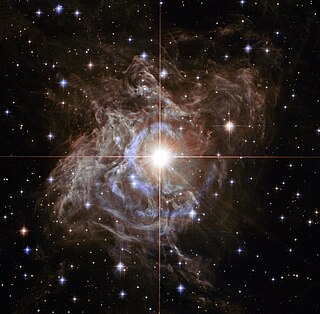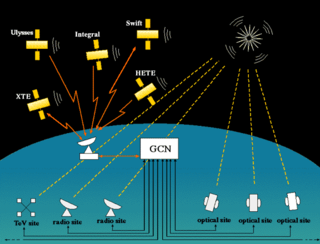
A Cepheid variable is a type of variable star that pulsates radially, varying in both diameter and temperature. It changes in brightness, with a well-defined stable period and amplitude.

In astronomy, seeing is the degradation of the image of an astronomical object due to turbulence in the atmosphere of Earth that may become visible as blurring, twinkling or variable distortion. The origin of this effect is rapidly changing variations of the optical refractive index along the light path from the object to the detector. Seeing is a major limitation to the angular resolution in astronomical observations with telescopes that would otherwise be limited through diffraction by the size of the telescope aperture. Today, many large scientific ground-based optical telescopes include adaptive optics to overcome seeing.

Stardome Observatory is a public astronomical observatory situated in Maungakiekie/One Tree Hill Domain in Auckland, New Zealand.

Siding Spring Observatory near Coonabarabran, New South Wales, Australia, part of the Research School of Astronomy & Astrophysics (RSAA) at the Australian National University (ANU), incorporates the Anglo-Australian Telescope along with a collection of other telescopes owned by the Australian National University, the University of New South Wales, and other institutions. The observatory is situated 1,165 metres (3,822 ft) above sea level in the Warrumbungle National Park on Mount Woorat, also known as Siding Spring Mountain. Siding Spring Observatory is owned by the Australian National University (ANU) and is part of the Mount Stromlo and Siding Spring Observatories research school.

Roque de los Muchachos Observatory is an astronomical observatory located in the municipality of Garafía on the island of La Palma in the Canary Islands, Spain. The observatory site is operated by the Instituto de Astrofísica de Canarias, based on nearby Tenerife. ORM is part of the European Northern Observatory.

An astronomical survey is a general map or image of a region of the sky that lacks a specific observational target. Alternatively, an astronomical survey may comprise a set of images, spectra, or other observations of objects that share a common type or feature. Surveys are often restricted to one band of the electromagnetic spectrum due to instrumental limitations, although multiwavelength surveys can be made by using multiple detectors, each sensitive to a different bandwidth.

Las Campanas Observatory (LCO) is an astronomical observatory owned and operated by the Carnegie Institution for Science (CIS). It is in the southern Atacama Desert of Chile in the Atacama Region approximately 100 kilometres (62 mi) northeast of the city of La Serena. The LCO telescopes and other facilities are near the north end of a 7 km (4.3 mi) long mountain ridge. Cerro Las Campanas, near the southern end and over 2,500 m (8,200 ft) high, is the future home of the Giant Magellan Telescope.

BOOTES is a global network of robotic astronomical observatories with seven sites located in Spain, New Zealand, China, Mexico, South Africa and Chile. While the BOOTES-1 station in Spain is devoted to wide-field astronomy, the additional stations include a similar setup : the 0.6m diameter robotic telescope, the EMCCD camera at the Cassegrain focus and the u'g'r'i'ZY filterset, which makes the BOOTES Network a unique resource for combining the data from all the instruments worldwide.

The General Coordinates Network (GCN), formerly known as the Gamma-ray burst Coordinates Network, is an open-source platform created by NASA to receive and transmit alerts about astronomical transient phenomena. This includes neutrino detections by observatories such as IceCube or Super-Kamiokande, gravitational wave events from the LIGO, Virgo and KAGRA interferometers, and gamma-ray bursts observed by Fermi, Swift or INTEGRAL. One of the main goals is to allow for follow-up observations of an event by other observatories, in hope to observe multi-messenger events.

The Virgo interferometer is a large Michelson interferometer designed to detect the gravitational waves predicted by general relativity. It is located in Santo Stefano a Macerata, near the city of Pisa, Italy. The instrument's two arms are three kilometres long, housing its mirrors and instrumentation inside an ultra-high vacuum.

W Mensae is an unusual yellow supergiant star in the Large Magellanic Cloud in the southern constellation Mensa. It is an R Coronae Borealis variable and periodically decreases in brightness by several magnitudes.

HM Cancri (also known as HM Cnc or RX J0806.3+1527) is a binary star system about 1,600 light-years (490 pc; 1.5×1016 km) away. It comprises two dense white dwarfs orbiting each other once every 5.4 minutes, at an estimated distance of only 80,000 kilometres (50,000 mi) apart (about 1/5 the distance between the Earth and the Moon). The two stars orbit each other at speeds in excess of 400 kilometres per second (890,000 mph). The stars are estimated to be about half as massive as the Sun. Like typical white dwarfs, they are extremely dense, being composed of degenerate matter, and so have radii on the order of the Earth's radius. Astronomers believe that the two stars will eventually merge, based on data from many X-ray satellites, such as Chandra X-Ray Observatory, XMM-Newton and the Swift Gamma-Ray Burst Mission. These data show that the orbital period of the two stars is steadily decreasing at a rate of 1.2 milliseconds per year as they thus are getting closer by approximately 60 centimetres (2.0 ft) per day. At this rate, they can be expected to merge in approximately 340,000 years. With a revolution period of 5.4 minutes, HM Cancri is the shortest orbital period binary white dwarf system currently known.

Integral field spectrographs (IFS) combine spectrographic and imaging capabilities in the optical or infrared wavelength domains (0.32 μm – 24 μm) to get from a single exposure spatially resolved spectra in a bi-dimensional region. The name originates from the fact that the measurements result from integrating the light on multiple sub-regions of the field. Developed at first for the study of astronomical objects, this technique is now also used in many other fields, such bio-medical science and Earth remote sensing. Integral field spectrography is part of the broader category of snapshot hyperspectral imaging techniques, itself a part of hyperspectral imaging.

Time-domain astronomy is the study of how astronomical objects change with time. Though the study may be said to begin with Galileo's Letters on Sunspots, the term now refers especially to variable objects beyond the Solar System. Changes over time may be due to movements or changes in the object itself. Common targets included are supernovae, pulsating stars, novas, flare stars, blazars and active galactic nuclei. Visible light time domain studies include OGLE, HAT-South, PanSTARRS, SkyMapper, ASAS, WASP, CRTS, GOTO and in a near future the LSST at the Vera C. Rubin Observatory.

A kilonova is a transient astronomical event that occurs in a compact binary system when two neutron stars or a neutron star and a black hole merge. These mergers are thought to produce gamma-ray bursts and emit bright electromagnetic radiation, called "kilonovae", due to the radioactive decay of heavy r-process nuclei that are produced and ejected fairly isotropically during the merger process. The measured high sphericity of the kilonova AT2017gfo at early epochs was deduced from the blackbody nature of its spectrum.
BlackGEM is an under-construction array of optical telescopes located at the La Silla astronomical observatory in Chile. This system is specifically designed to detect the optical counterparts from gravitational wave sources detected with Virgo and LIGO. Principal investigator of the array is Paul Groot.

GW 170817 was a gravitational wave (GW) signal observed by the LIGO and Virgo detectors on 17 August 2017, originating from the shell elliptical galaxy NGC 4993. The signal was produced by the last moments of the inspiral process of a binary pair of neutron stars, ending with their merger. It is the first GW observation that has been confirmed by non-gravitational means. Unlike the five previous GW detections—which were of merging black holes, and thus not expected to produce a detectable electromagnetic signal—the aftermath of this merger was seen across the electromagnetic spectrum by 70 observatories on 7 continents and in space, marking a significant breakthrough for multi-messenger astronomy. The discovery and subsequent observations of GW 170817 were given the Breakthrough of the Year award for 2017 by the journal Science.
The Zwicky Transient Facility is a wide-field sky astronomical survey using a new camera attached to the Samuel Oschin Telescope at the Palomar Observatory in California, United States. Commissioned in 2018, it supersedes the (Intermediate) Palomar Transient Factory (2009–2017) that used the same observatory code. It is named after the astronomer Fritz Zwicky.

M101 OT2015-1 is a contact binary that merged into a single star, in a process known as a luminous red nova (LRN). M101 OT2015-1 is an optical transient located in the Pinwheel Galaxy (M101). Luminous red novae are representatives of the sparsely populated class of exploding variables which is known since 1988 when such a star (M31-RV) appeared in the M31 galaxy.
LiteBIRD is a planned small space observatory that aims to detect the footprint of the primordial gravitational wave on the cosmic microwave background (CMB) in a form of polarization pattern called B-mode.


















